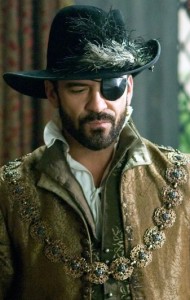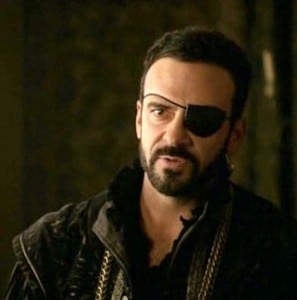 On this day in history, 2nd February 1550, Sir Francis Bryan died suddenly at Clonmel in Ireland. He had settled in Ireland after marrying Joan Butler, dowager countess of Ormond, and had travelled to Tipperary as Lord Justice “to check the incursions of the O’Carrolls”.
On this day in history, 2nd February 1550, Sir Francis Bryan died suddenly at Clonmel in Ireland. He had settled in Ireland after marrying Joan Butler, dowager countess of Ormond, and had travelled to Tipperary as Lord Justice “to check the incursions of the O’Carrolls”.
In “The Tudors”, Sir Francis Bryan is a one-eyed rake who likes to have his wicked way with the ladies, but was the real Sir Francis Bryan really like that? Here are some facts about him:-
- He did indeed have one eye – He lost an eye jousting in 1526 and historian Susan Brigden writes of how he joked about it “for he wrote of the one-eyed Robert Aske ‘I know him not, nor he me … yet we have but two eyes’ (LP Henry VIII, 11.1103)”.
- His birthdate is not known but is thought to be around 1490.
- He was the first surviving son of Sir Thomas Bryan and Lady Margaret Bryan (née Bourchier) who was lady-in-waiting to Queen Catherine of Aragon and governess to Princess Mary, Princess Elizabeth and Prince Edward.
- Brigden believes that Bryan may have spent some of his youth in the household of Sir Thomas Parr of Kendal, Westmorland, in Northamptonshire because he later referred to him as his patron. Parr was the father of Queen Catherine Parr.
- His sister, Elizabeth, married Sir Nicholas Carew.
- He was Anne Boleyn’s cousin – His mother was Elizabeth Boleyn’s half-sister.
- In April 1513 he was Captain of the Margaret Bonaventure.
- In 1516 he became the King’s cupbearer.
- He was known for his skills at jousting and hunting and became the King’s master of the toils in 1518, a position he held for the rest of Henry VIII’s reign.
- He was also known for his rich clothing.
- in 1518 he became a gentleman of the privy chamber – He lost this position in Wolsey’s purge but then regained it in 1528.
- Bryan was knighted in 1522 for his courage during the capture of Morlaix in Brittany, serving under the Earl of Surrey.
- His first wife, who he was married to by 1522, was Philippa, daughter and heir of Humphrey Spice and widow of John Fortescue of Ponsbourne in Hertfordshire. The marriage was childless.
- Bryan had a reputation for gambling and was a court favourite.
- By 1526 he held the position of chielf cupbearer and master of the henchmen.
- During the King’s Great Matter, Bryan was Henry VIII’s “trusted emissary to those with most power to bring about the king’s remarriage: Clement VII and François”.

- Brigden writes of Bryan, “Bryan became known for his unusual willingness to tell the king the truth, but also for his employment of dubious means to gain diplomatic ends”, and writes of how he slept with a courtesan at the papal court to gain intelligence.
- Bryan was the one who informed the King of his excommunication in August 1533.
- In the 1530s he served as sheriff, JP and MP.
- In May 1536, when the Boleyns fell from power, he was summoned to London for questioning but was not arrested. He had previously distanced himself from the Boleyns and allied himself with the Seymours.
- Bryan was sent to tell Jane Seymour the news of Anne Boleyn’s execution and benefited from Anne’s fall, becoming Chief Gentleman of the King’s Privy Chamber.
- Thomas Cromwell referred to Bryan as “the vicar of Hell” in a letter to Gardiner and Wallop on the 14th May 1536. According to Catholic recusant Nicholas Sander, the King also referred to him by this nickname. Sander writes “This man was once asked by the king to tell him what sort of a sin it was to ruin the mother and then the child. Bryan replied that it was a sin like that of eating a hen first and its chicken afterwards. The king burst forth into loud laughter, and said to Bryan, “Well, you certainly are my vicar of hell.” The man had been long ago called the vicar of hell on account of his notorious impiety, henceforth he was called also the king’s vicar of hell.”
- Bryan’s motto was Je tens grace (‘I look for salvation’) and he was a staunch Catholic. Brigden writes “He owned a copy of the Matthew Bible of 1537, and was intrigued by the humanist enterprise of scriptural translation and exegesis. Although he could not translate scripture himself, he was the patron of scholars of Greek who could, and his own household was a kind of academy.”
- In 1537 he was sent to Paris to secretly arrange the kidnap or assassination of Cardinal Pole but it was suspected that he actually tipped Pole off.
- He acted as ambassador to Francis I in 1538 in Nice while Thomas Wyatt acted as ambassador to Charles V but was recalled due to his reckless gambling, drunkenness and all round bad behaviour. He never acted as ambassador to the French king ever again.
- Bryan sat on the jury which found his brother-in-law, Carew, guilty of treason in 1539.
- He was appointed vice-admiral in January 1543 but this was revoked in the February after he went against the instructions of John Dudley, Viscount Lisle and lord admiral.
- In October 1543 he acted as ambassador to Charles V.
- In October 1546 he was given the freedom of the City of London.
- He was made knight-banneret in 1547 for his role in the expedition against the Scots as commander of the horse.
- After his wife’s death in 1542 “he followed Wyatt’s satirical advice to marry a wealthy widow” and in 1548 married Joan Butler, dowager countess of Ormond, and daughter of James fitz Maurice Fitzgerald, tenth earl of Desmond.
- Brigden describes how “through his marriage Bryan wielded Ormond authority in south Leinster, controlling the estates of Thomas Butler, tenth earl of Ormond (1531–1614), in his minority and a private army of gallowglasses in co. Kilkenny” and “Through the office of lord marshal, to which he was appointed in January 1549, he commanded royal forces in Ireland”. Bryan had become a powerful and wealthy man.
- He died in Ireland on the 2nd February 1550, his last words allegedly being “‘I pray you, let me be buried amongst the good fellows of Waterford (which were good drinkers)’”.
- Like his good friend Thomas Wyatt, Bryan was a poet.
- Thomas Wyatt wrote of Bryan:
“To thee, therefore, that trots still up and down
And never rests, but running day and night
From realm to realm, from city, street, and town,
Why dost thou wear thy body to the bones?” - There are no portraits of Sir Francis Bryan.
Notes and Sources
- Susan Brigden, ‘Bryan, Sir Francis (d. 1550)’, Oxford Dictionary of National Biography, Oxford University Press, 2004
- Nicholas Sander, Rise and Growth of the Anglican Schism